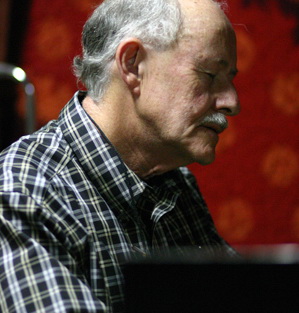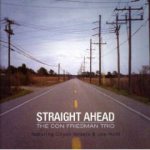Pivoting Modes – Don Friedman
Don's reworking of Modes Pivoting, 45 years later. It's clearly closely related, but many elements are strikingly different.
- Recording: Don Friedman - Straight Ahead
- Recorded on: July 26, 2007
- Label: No Coast Jazz Records (NCJR 01)
- Concert Key: E minor
- Vocal Range: , to
- Style: Swing (medium up)
- Piano - Don Friedman
- Bass - Chuck Israels
- Drums - Joe Hunt
Video
- Description
- Historical Notes
- Solos
- Piano Corner
- Bass Corner
- Drum Corner
- Guitar Corner
- Inside & Beyond
- Minus You
Pivoting Modes demonstrates an alternate approach to the same melodic and harmonic material as Modes Pivoting. The tempo is quite a bit slower than Modes Pivoting, and the feel is different. In the A section, the melody is similar, with a few different rhythms. The bass plays long notes with rhythmic pickups which fill in below the melody. The bridge has the same descending II-V7 changes as that of Modes Pivoting, but the melody is higher in range and more rhythmic. The bass and drums play with a loose two-feel on the bridge. The C section starts the same as A; the fifth through ninth measures of this section are where the head differs the most from Modes Pivoting. In these measures the melody climbs over an octave, with added changes that rise and fall; the Emaj7 melody uses A♮ [natural] instead of A♯;. The last six measures of C start with rhythmic figures over descending II-V7s as in Modes Pivoting, with a descending turnaround added in the last two measures.
The solo changes are notably different from Modes Pivoting. They are no longer properly modal; the E minor sections alternate between a measure each of Em7 and Fmaj7(♯11), and the B minor section similarly alternates with Cmaj7(♯11). The rest of the solo changes are like the head changes. Don plays over these alternating chords; soloists have the option of interpreting the tonic minor chords as Phrygian, using the same scale as the alternating major chords. The rhythm section plays a loose two-feel for most of the solo chorus, going to four-feel on the bridge but switching back to two-feel in the seventh measure of that section.
This recording has no intro. The ending replaces the last two measures of the head with an ascending eighth-note line over descending half notes in the bass, finishing on Em(maj7).
The solo changes are notably different from Modes Pivoting. They are no longer properly modal; the E minor sections alternate between a measure each of Em7 and Fmaj7(♯11), and the B minor section similarly alternates with Cmaj7(♯11). The rest of the solo changes are like the head changes. Don plays over these alternating chords; soloists have the option of interpreting the tonic minor chords as Phrygian, using the same scale as the alternating major chords. The rhythm section plays a loose two-feel for most of the solo chorus, going to four-feel on the bridge but switching back to two-feel in the seventh measure of that section.
This recording has no intro. The ending replaces the last two measures of the head with an ascending eighth-note line over descending half notes in the bass, finishing on Em(maj7).
The personnel on this album is the same as on Don's debut album for Riverside, "A Day In The City," from 1961. For more from "Straight Ahead" check out Flamands and Minor Ballade. "Straight Ahead" was both Chuck Israels' and Joe Hunt's only recording in 2007. Israels and Hunt played together with George Russell in 1960 and with Stan Getz in 1964.
Related Songs
Email Send Pivoting Modes to a friend
Send this page to a friend via email. Add your name or email in the first field. In the second, add one or more email addresses, separated by a comma.

Don Friedman
May 4, 1935 – June 30, 2016
Don Friedman was only four years old, living in San Francisco, when he started playing his parents' piano. A year later, he started lessons with a private teacher. His love for jazz music was born when he moved to L.A. and heard the likes of Les Brown and Lee Konitz for the first time. Read more...
There was a problem.
...

